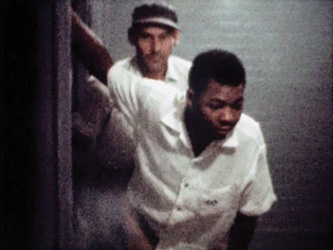William E. Jones, Still from Tearoom, 1962/2007.
Born 1962 in Canton, Ohio; lives in Los Angeles, California
Filmmaker William E. Jones edits together sequences from vintage 1970s and 1980s gay porn to create a discursive arena in which to consider the desires implicit in sexual imagery. His short films are at once explorations of the complexities of homosexual identity and nostalgic recollections of an erstwhile gay culture drastically altered since the onset of AIDS. For the most part editing out hard-core scenes, Jones allows his pieces to focus on the language of body movement and even landscape as sites for subtler fantasy and romanticism.
Earlier works, like his 2004 music documentary Is It Really So Strange?, contextualize Jones’s more pornographic, cinematically experimental pieces as highly specific fascinations with fetish and style in popular culture. Formally, his shorts retain some of the camp qualities inherent to the films they were cut from, with awkwardly staged situations, bad acting, and diverse sexual settings. In this they’re akin to Jack Smith’s and George Kuchar’s filmic experiments. For more recent works, however, Jones has downplayed the camp aspect by showing found footage without soundtrack or splicing in ironic audio alternatives to lend layers of cultural reference to footage rooted firmly in a specific time and place.
V. O. (2006), whose title puns on voice-over and version originale, is a montage of vignettes taken from various films re-presented with French, English, Finnish, German, Portuguese, and Spanish dialogue, English subtitles, and classical music from movie soundtracks including Delivery Boys, Der Tod der Maria Malibran, and Amor de Perdição. Each segment highlights interactions between men that symbolize their desires for physical contact. V. O. opens with a pizza deliveryman hypnotized into sexual reverie by a Victrola playing a recording that suggests, “You are an extraordinary factory of natural medication.” In the fourth section, footage of a man delving into a masturbatorUn chant d’amour (1950) by concurrently presenting an interview with Genet. Poetic text sets a historical precedent for each segment, offering the potential for a deeper, more sympathetic understanding of pornography’s content.
Tearoom (1962/2007) takes a comparable thematic approach to fetishism, though it is rooted in the real rather than the imagined. The grainy color found footage of sexual interactions between men in a public restroom was shot by a hidden camera as part of a 1962 police sting to be used as evidence supporting sodomy charges. Other than moving the last reel to the beginning of the film, Jones left the footage unedited. Presented in long, visually similar sequences without soundtrack and punctuated by blank white screens, the men’s actions begin neutrally and become increasingly risqué. The footage slowly builds up to the impassioned crescendo more typical of traditional porn; tightly edited shots of men masturbating and having sex underpin the film’s voyeuristic nature. The silence of Tearoom metaphorically reiterates the suspicion and secrecy these men are forced to endure, elucidating, as in all of Jones’s films, an omnipresent struggle for freedom through subversion. TRINIE DALTON
William E. Jones, Still from Tearoom, 1962/2007. 16mm film transferred to video, color, silent; 56 min. Collection of the artist.
























